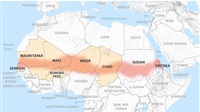'An American fiasco': US hits grim milestone of 2m Covid-19 cases

For
Americans, coronavirus went from being a mysterious affliction that occurred in
far-off lands to 1m confirmed cases on US soil within 14 weeks. Now, just six
weeks later, the US has broken through the grim milestone of 2m positive tests
for Covid-19, according to the Johns Hopkins University tracker.
The
anguish of life lost, of a severely wounded economy and wrenching political
turmoil have taken a harrowing toll upon a fatigued American public. But
further, perhaps far greater pain is yet to come, pandemic experts have warned,
even as authorities wave people back into reopened shops and offices and the US
president’s political rhetoric on an epochal crisis dwindles away to near
silence.
“Everyone
has just looked at the first 100 yards of this marathon,” said Michael
Osterholm, the director of the Center for Infectious Disease Research and
Policy at the University of Minnesota.
Osterholm
said a society usually becomes resilient to a virus once at least 60% of the
population has been infected, either naturally or via a vaccine, and develops
antibodies. This is still a far-off point for the US, with no firm guarantee a
working vaccine will ever be developed.
“At
most, perhaps 5% of people have been infected,” he said. “If all that pain,
suffering and economic destruction got us to 5%, what will it take to get us to
60%? That’s a sobering thought. All of that suffering and death is just getting
started. People haven’t quite got that yet.”
The
true figure of infection in the US is almost certainly “multiples more” than
the 2m confirmed cases, said Irwin Redlener, the director of the National
Center for Disaster Preparedness at Columbia University, but is obscured to the
lack of testing.
Problems
in developing and rolling out an effective test dogged the initial US response
to the pandemic and although testing has now ramped up, only around 6% of the
population has received one.
People
with Covid-19 most likely experience either no noticeable symptoms or only
minor symptoms such as a dry cough and mild fever.
“We are very much seeing only the
proverbial tip of the iceberg,” said Redlener. “We are hampered by the lack of
sufficient testing, especially as businesses are reopening across all 50 states.”
Deficiencies
in the stockpile of testing kits, swabs, ventilators and protective equipment
for medical staff marked the opening stanza of the pandemic in the US. It was a
muddled and sometimes astonishing response embodied by Donald Trump, who
predicted the virus would vanish in the April sunshine, squabbled with state
governors and pondered the merits of injecting bleach or taking
hydroxychloroquine, an unproven anti-malarial drug.
“From the beginning there has been
misrepresentations and fabrications from the White House,” said Redlener.
“Whatever the opposite of ‘mission accomplished’ is, that’s what this is. It’s
essentially been an American fiasco.”
Yet
even as the US has surged past 100,000 deaths from Covid-19, around a quarter
of the entire global total, the crisis has faded from the political agenda.
Trump,
preoccupied with sending in the military to crush roiling anti-racism protests
over the death of George Floyd, has stopped daily press conferences on the
pandemic. Re-openings have been left down to the states, conducted in a
somewhat haphazard way with at least a dozen states still experiencing rising
rates of infections.
Dr
Anthony Fauci, the administration’s top infectious disease expert, has admitted
not seeing the president in weeks despite the ongoing public health crisis.
“Where is it going to end? We’re still at the beginning of it,” Fauci said this
week.
A
disconcerting element of the crisis for epidemiologists is that so much about
Covid-19 is still unknown. The World Health Organization had to clarify it
still doesn’t know how often asymptomatic people pass on the virus, after
previously saying it was very rare.
It’s
not known why some people grouped together, such as meatpacking workers, have
become infected at high rates while others, such as prisoners, haven’t to the
same degree. There’s uncertainty over how the virus will react to the summer
heat or how big a second or third wave of infections will be. Even the symptoms
of the virus, previously thought to always include a fever and cough, have
confounded previous expectations.
“There are a lot of things we just
don’t know and we need a great deal of humility. We aren’t driving this tiger,
we are riding it,” said Osterholm.
The
decisions made as the virus rumbles on will invariably become as political and
moral as they will scientific.
With
more than 40 million people already out of work in the US amid an economic
downturn that may rival anything seen in the past century, any escalation of
lockdown to stop the spread of the virus will risk unbearable mental and
financial pain. On the other extreme, attempting to revert to previous patterns
of life without a vaccine would likely overwhelm hospitals with the sick and
dying.
“We
need to really thread the needle between those two things,” said Osterholm. “I
worry we have passed over having that difficult conversation. We’ve already
decided that it’s over and done with. It’s not.”







